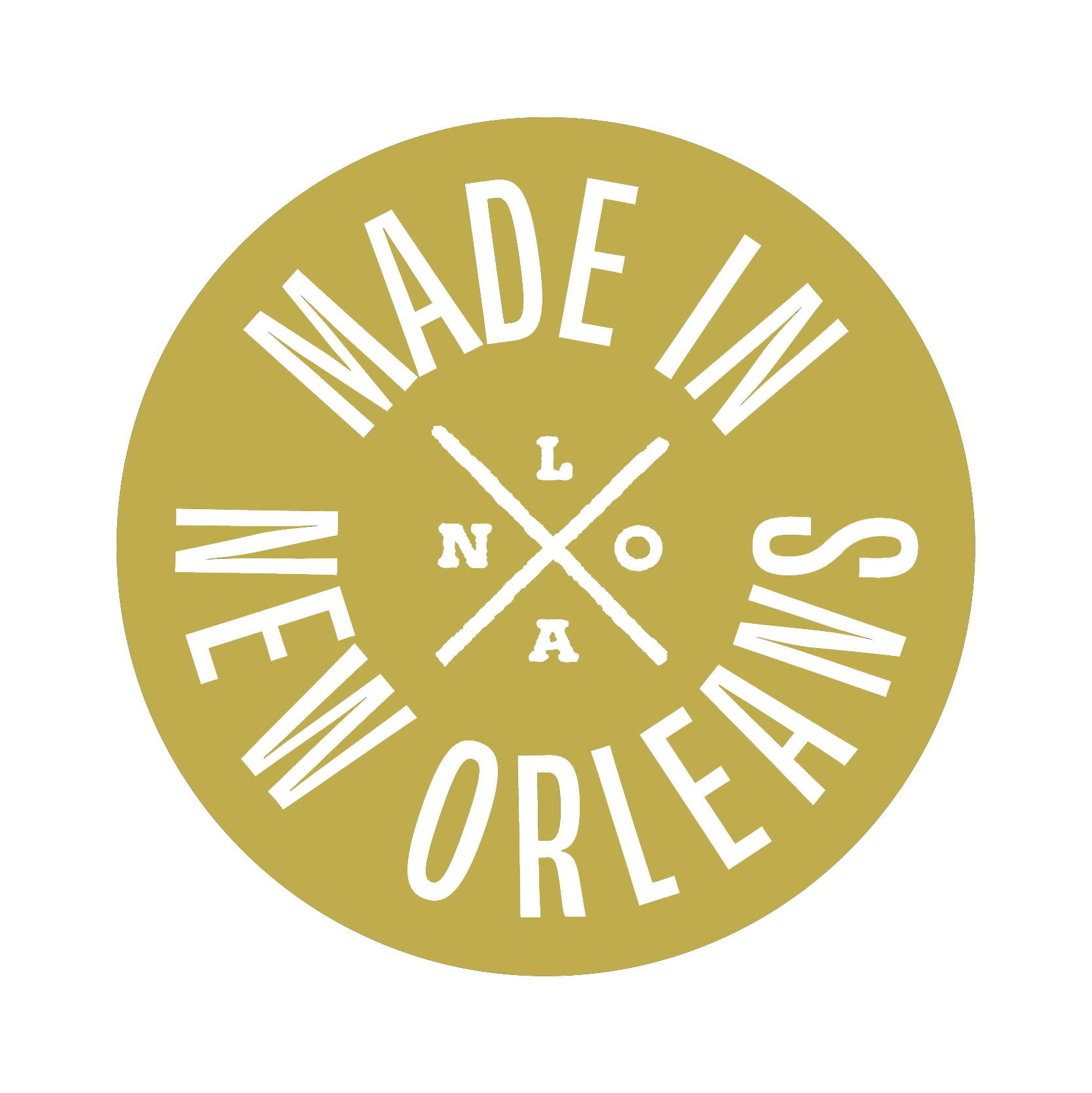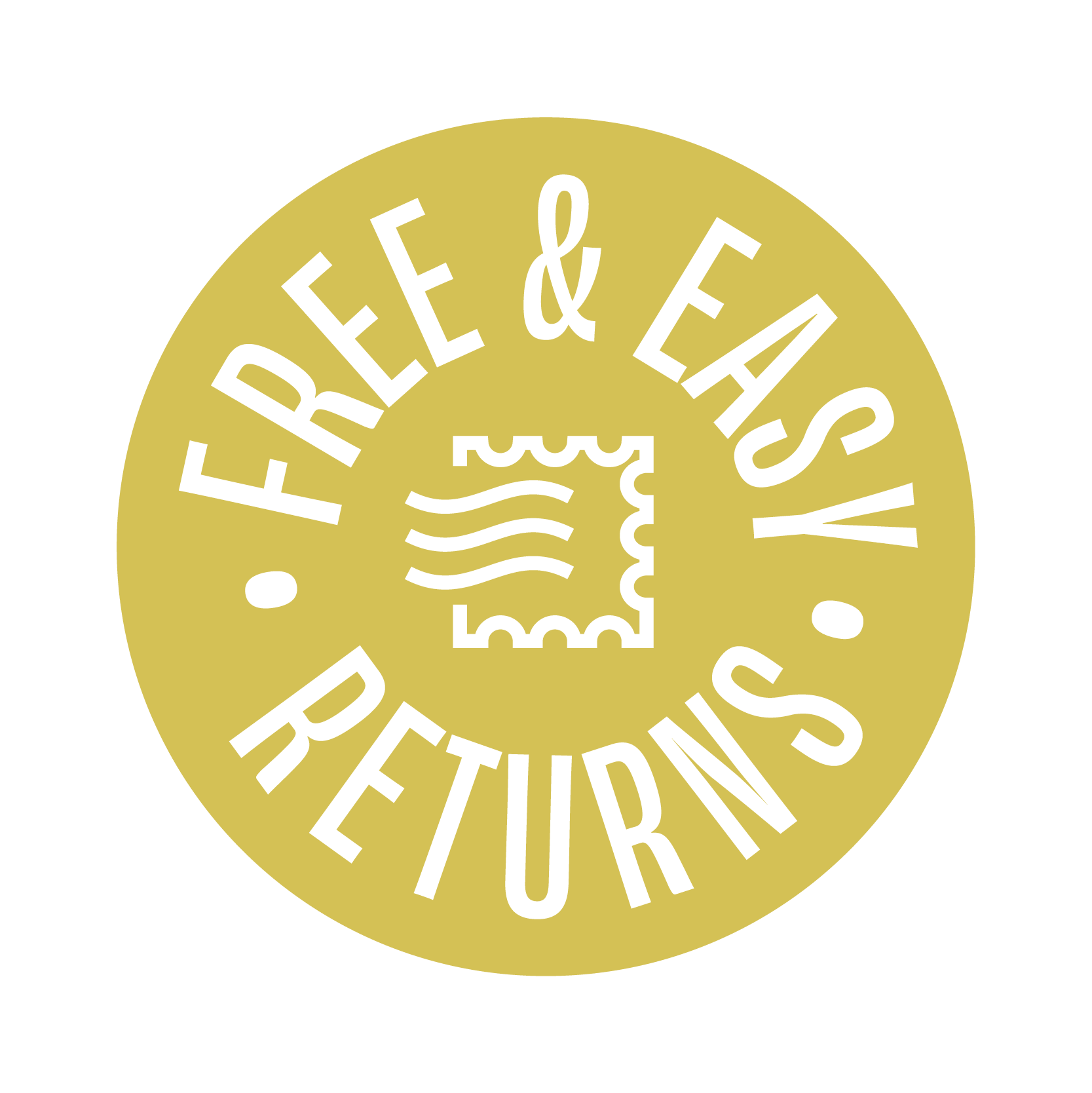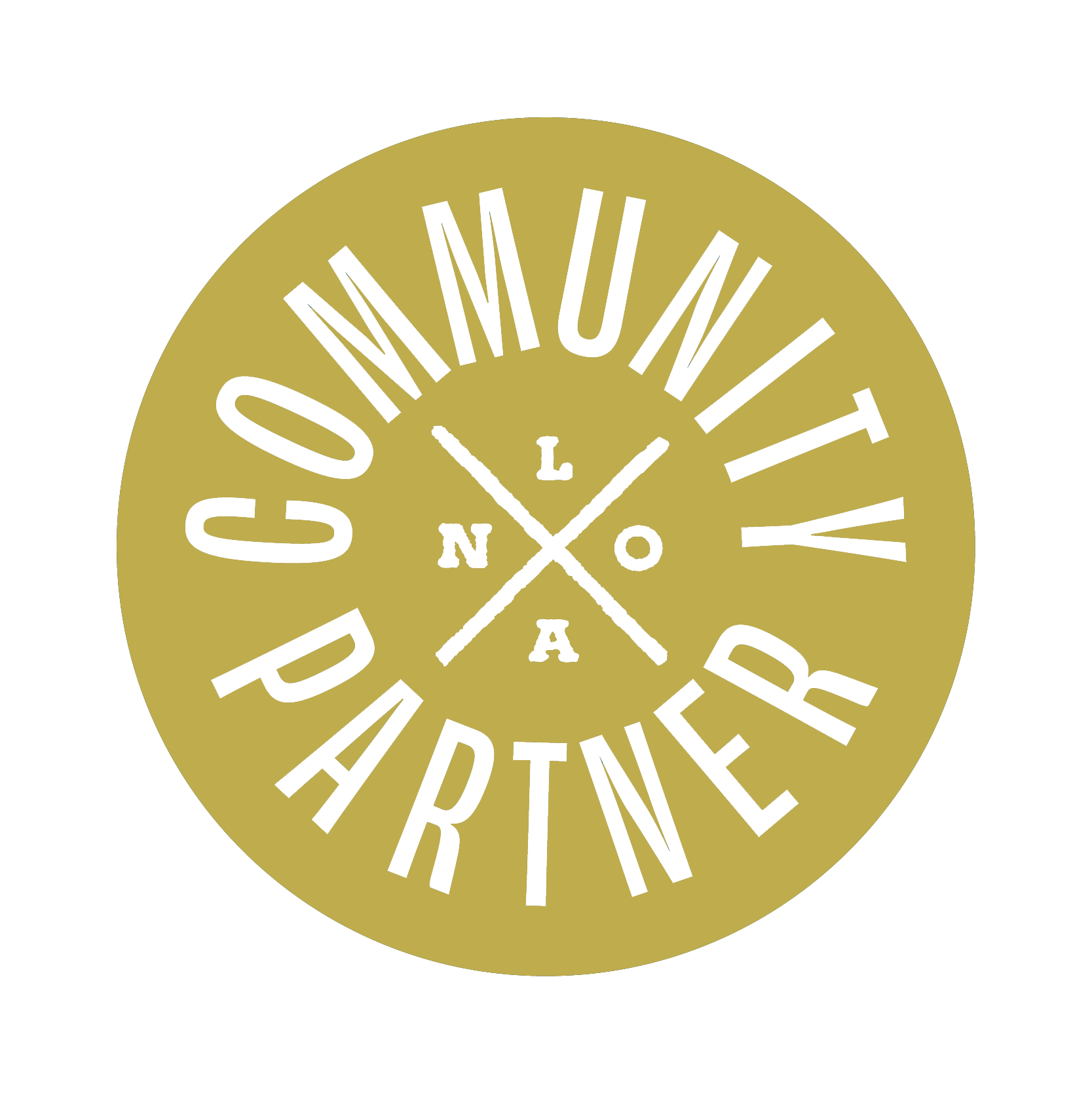Avery was one of the earlier illustrators who could handle very ornate and detailed concepts. Whatever we sent his way, he knocked out the park. A talented artist who now resides in Ann Arbor, Michigan with his wife and 2 kids. Interview with Blake.
Avery
I’ve been coming back from time to time to check in from up here in Ann Arbor. The site is looking great — the new releases, everything. You guys are at 20 years now, right? Started in 2005?
Blake
I first had the idea about 21 years ago, in 2004. I bought the domain name that November, once I finally decided what it was going to be called — and luckily, it was available. I spent about a year working on concepts, and once we had around 10 designs ready, I started laying out the website.
I was taking my time… and then Katrina happened. I designed the “Be a New Orleans” sticker, and once I saw the reaction, it hit me: of course a place-based, local pride brand would resonate after a disaster like that.
I partnered with Patrick so he could handle operations while I kept my studio going, and off we went. So yes — it’s been about 20 years. I’ve been looking back recently, doing conversations with people who have worked with Dirty Coast over the years.
Part of planning this book has been diving into my Gmail and looking for the first correspondence I had with people — just as a starting point. When I looked you up, the first email was from early 2009
Avery
Well, when you asked me, I started reflecting on that whole time — both in my life and in moving to New Orleans. I’d just relocated without a job. Well, technically I had one: I was freelancing, illustrating a fine-press edition of The Iliad and The Odyssey. I’d done most of that work in Virginia, essentially at my parents’ house.
After college, I got that illustration job about a month after graduating, moved home for a few months, and then realized a bunch of friends were relocating from Philly to New Orleans — and I wanted to join them. I’m not even sure what I had to wrap up in Charlottesville before leaving, but I got to New Orleans, finished the illustration gig, and thought, Maybe this could actually be a career — doing illustration.
Avery
Around that time, I discovered Dirty Coast and you. I remember… gently stalking you at Dirty Coast events. If something was happening, I’d be like, “Hey, everyone, we’re going to Dirty Coast tonight,” because I wanted to be there, say hi, and be seen.
I also remember something at Tulane — some designer was giving a talk — and I tapped you on the shoulder and said, “Hey Blake, I’m Avery, remember me?” And you were like, “Oh yeah, what’s up Avery?” And I thought, Oh wow, he remembers me. Awesome.
After that, I took some of those illustrations and other work I’d done in college and put together a little portfolio. I didn’t have any formal training in illustration or the business side of art, and I wasn’t sure how to sell myself. But I knew I needed something to show, so I made this trifold piece — just printed on 8.5x11 at Kinko’s because that’s what I could afford — with a special fold. I sent it to you, saying I was interested in working with Dirty Coast. I’m guessing that’s what kicked off our first real conversation.
Blake
If that’s all true, I’m very glad for your persistence. I’m sure if that was the actual process of us first connecting, then once I saw your portfolio I thought, Yeah… if you can illustrate like that, I’m sure I have plenty of ideas to send your way.
I think about some of those early pieces — the Absinthe design, the Jean Lafitte — they were mainstays for years. That’s usually a good sign of a strong design or concept.
Avery
For each of those two, I have such distinct memories of working on them — where I was in life, emotionally, geographically, and who my friends were. Usually, those friends got pulled into the work somehow.
For Johnny Vidacovich, I remember going to see him play — I think at the Maple Leaf. That project got me out into parts of the city I didn’t usually go.
For the Jean Lafitte piece, I actually had my girlfriend at the time put on tights so I could pose her for reference — I wanted the stance to feel authentic.
By the time I worked on the Absinthe design, that girlfriend had dumped me. I was working for Flavor Paper, they had moved to New York, and so had she. I ended up moving back to Virginia with my tail between my legs to figure things out. I was living with a couple at the time, and I had them pose for the Absinthe piece so I could get the right reference.
Each one of those designs has a story. For example, I was working on the Po’ Boy Patent in a little studio I’d set up in Charlottesville. That’s actually when I first met Emily — before we were dating. She saw me sketching one of the ingredients for that design in that studio when we first met.
Blake
I distinctly remember seeing an illustration in The New York Times Sunday edition — an article about how the U.S. Senate works. It was this big, blowout visual of the Capitol building. It immediately sparked the thought: What New Orleans thing could we “blow out” in that style? Of course, anything with layers came to mind — and I’m certain I thought of you right away.
Avery
That one was so fun to work on. I’d been aware of patent illustrations before, but having to do actual research for that project made me realize — holy shit — these things used to be incredible. They were such beautiful, detailed graphics.
They’re a lot more boring now, but back then they had real character. Oh, and one time I hid Emily’s name in the ice cubes of the Bloody Mary patent illustration — it literally says “Emily.”
Blake
What are some other designs? I’ve been looking back at the archives of things you’ve worked on. One of the last ones you did was the Magnolia.
Avery
Right, yeah. Those were fun to work on. That was when I moved back to New Orleans after grad school. My sister was living in Baton Rouge then, so for a while our family had this center of gravity down in Louisiana. It didn’t last forever — we all eventually left again — but for that moment, it felt like we were rooted there.
I remember the dog illustration… I think I just found the reference online, but for the Magnolia, I walked around City Park trying to get inspiration. Maybe I did the same for the dog too — just to gather details for the background, like the ferns behind the dog in that design.
Of course, there are always some pieces I like less than others. That’s just the nature of the work — sometimes you’re really happy with it, sometimes less so, but it still comes together. I remember the Yacht Rock Party design — I thought it was okay, but it was still fun to put together.
Mostly, though, the real joy has been giving the work as gifts — especially to my family. I’ve got two older sisters, and between them they have six kids. I love getting the toddler and youth sizes of my designs and giving them to my nieces and nephews. I’ll say, “Hey, Uncle Avery did that,” and they’ll light up.
Blake
Oh — America: The Party.
Avery
Yes! America: The Party. Those were harder to work on because I had already left New Orleans. I was enjoying life in Virginia, but I still had friends in the city, and sometimes I’d think, Should I have stayed? Then you’d email me about having this huge party and ask if I wanted to do the design, and I’d be like, I can’t believe I’m not there. And then the Saints won, and I really couldn’t believe I wasn’t there.
There was one time I really felt honored that you reached out for some extra brainpower — I think it was for the Saints fist design. I only suggested a small tweak, maybe skewing the angle a bit more or some little adjustment, but it was fun to be part of your brain trust on that quick project.
Beyond that, our relationship has also been about you giving me advice as a creative and entrepreneur. You connected me with people in New Orleans when I was trying to find my footing after grad school, figuring out how to take my arts training and turn it into a meaningful career.
In the end, New Orleans didn’t turn out to be the place for that next chapter. I had a lot of odd jobs after we moved back in 2015 — some of them fulfilling in their own way — but it wasn’t until we moved to Philadelphia that I landed a teaching job that felt most authentically me. That role has been the most fulfilling so far, both for my teaching and my own art practice.
Blake
Well, it’s very nice to hear that I was of some assistance.
Avery
You’ve been one of the main characters in my creative life — in my sometimes chaotic path of teaching animation, making animation, and working in illustration. First there was The Odyssey project that got things rolling, and then you, Blake Haney, were the reason I did a lot of illustration work. I’ve been lucky to see my drawings on Dirty Coast products over the years.
One of my favorites was the alligators pulling Santa. My family had this odd Christmas tradition — we’d do some kind of performance on Christmas Eve, which eventually evolved into parody movies on VHS. But it started with a dramatic reading of A Cajun Night Before Christmas. My dad would dress up as Old Saint Nick, the kids would dress as the gators — it was ridiculous.
Avery
So when you reached out about that design, I thought, Oh hell yes — I have the personal history for this one. I loved working on it. Santa’s just lounging in the sleigh with three gators pulling him — it still makes me smile. I think that might be the one I’m most proud of.
Blake
How often — in the past or recently — have you spotted your work out in the wild? And what’s that experience like for you?
Avery
Whenever I visit New Orleans, I always pop into the stores to see what’s on display. I remember the first time I went to the new airport and spotted one of my designs. Of course, the retail person didn’t really care when I said, “Hey, guess what? I did this one.” They were just like, “Oh, cool.”
Mostly, though, the real joy has been giving the work as gifts — especially to my family. I’ve got two older sisters, and between them they have six kids. I love getting the toddler and youth sizes of my designs and giving them to my nieces and nephews. I’ll say, “Hey, Uncle Avery did that,” and they’ll light up.
That’s probably been the most fun and satisfying way to see my work out in the world.
Where did you pick up the business side of things? How did you even know how much to charge people, or how to maintain all that? Was that something you learned in school
Blake
No, I just looked at what was happening with sites like Busted Tees, Threadless, and other early e-commerce shirt companies. They had pretty consistent pricing, so we just mimicked that. My plan was simple: put a few thousand dollars into paying for designs and the first run of merch. If we made our money back in a few months, I’d consider it a success — a good creative experiment.
As for running the store and dealing with customers, a lot of that I learned on the fly. Patrick handled most of the brick-and-mortar operations, while I focused on finances, marketing, and design. Our first website was entirely custom — back then in 2005, there was no Shopify. We had to build everything from scratch: the backend, the content management system, the checkout, even the customer management tools.
How often — in the past or recently — have you spotted your work out in the wild? And what’s that experience like for you?
Avery
Whenever I visit New Orleans, I always pop into the stores to see what’s on display. I remember the first time I went to the new airport and spotted one of my designs. Of course, the retail person didn’t really care when I said, “Hey, guess what? I did this one.” They were just like, “Oh, cool.”
Mostly, though, the real joy has been giving the work as gifts — especially to my family. I’ve got two older sisters, and between them they have six kids. I love getting the toddler and youth sizes of my designs and giving them to my nieces and nephews. I’ll say, “Hey, Uncle Avery did that,” and they’ll light up.
That’s probably been the most fun and satisfying way to see my work out in the world.
Where did you pick up the business side of things? How did you even know how much to charge people, or how to maintain all that? Was that something you learned in school
Blake
No, I just looked at what was happening with sites like Busted Tees, Threadless, and other early e-commerce shirt companies. They had pretty consistent pricing, so we just mimicked that. My plan was simple: put a few thousand dollars into paying for designs and the first run of merch. If we made our money back in a few months, I’d consider it a success — a good creative experiment.
As for running the store and dealing with customers, a lot of that I learned on the fly. Patrick handled most of the brick-and-mortar operations, while I focused on finances, marketing, and design. Our first website was entirely custom — back then in 2005, there was no Shopify. We had to build everything from scratch: the backend, the content management system, the checkout, even the customer management tools.
That was only possible because my business partner, Ben Hirsch, was such a talented developer. Really, none of this would have happened — or kept going — without being lucky enough to find the right people to collaborate with. And, of course, without New Orleans itself… thankfully the city keeps doing the occasional dumb thing to give us great material for social commentary.
Avery
Back in 2008 or 2009, my friends loved the Gray Ghost shirt. We were fascinated by that whole street art drama. We’d watch tags get painted over with gray, then reappear, then get covered again. My friend had an AmeriCorps job mixing paint, and he swore he knew who the Gray Ghost was because the same guy kept coming in to buy gray paint.
Blake
That was around the time I had the gallery and event space on Julia Street — Canary Gallery. Wild times.
Avery
I think I came to a film screening there… I can’t remember the film. I do remember you invited me to be part of that skateboard deck design project. That was great — I got to put on my “artist” hat. I didn’t do illustration for it. Instead, I played with a pun: “front side” and “back side.” I drew a head for the front, and for the back I used my dad — in his whitey-tighties — as a model.
I had those drawings laser-etched into pieces of plastic that served as the truck spacers for the skateboard. Then I made prints with them by stepping on the board. It was such a weird, fun project — another Blake Haney opportunity that pushed me into making something creative I wouldn’t have otherwise done.
Blake
And as much as you appreciate me setting up those opportunities for you, I have to say I appreciate having someone who can create such great work — and be so fun to work with.








Leave a comment
All comments are moderated before being published.
This site is protected by hCaptcha and the hCaptcha Privacy Policy and Terms of Service apply.